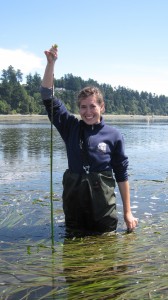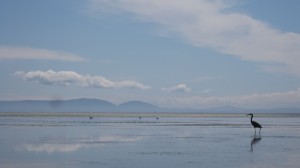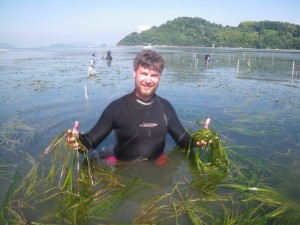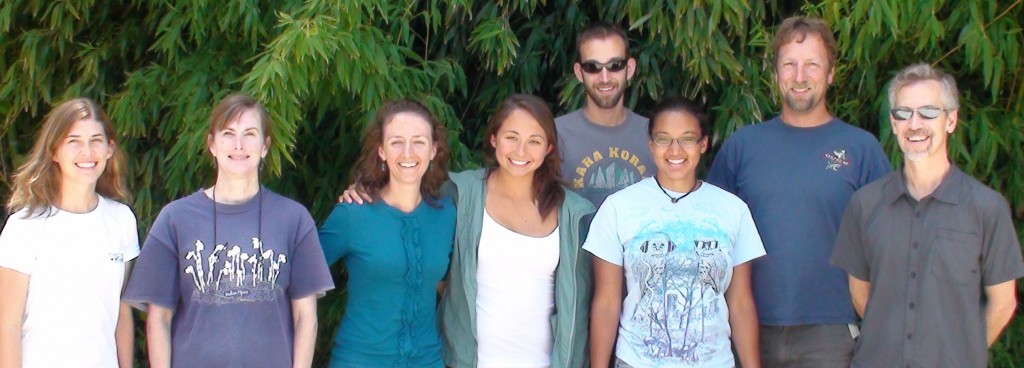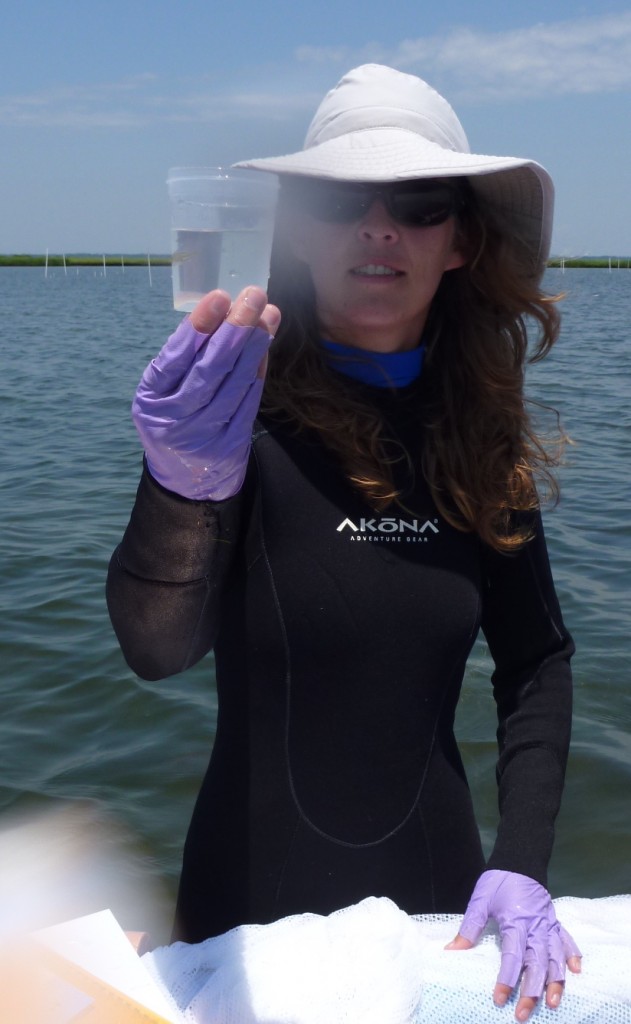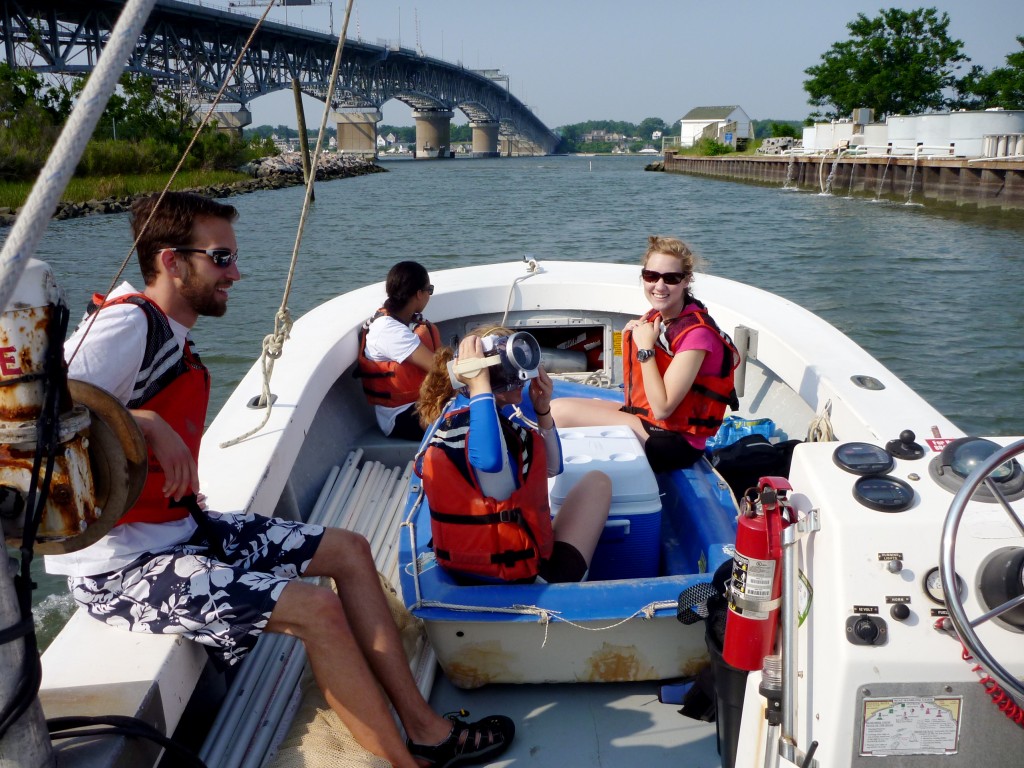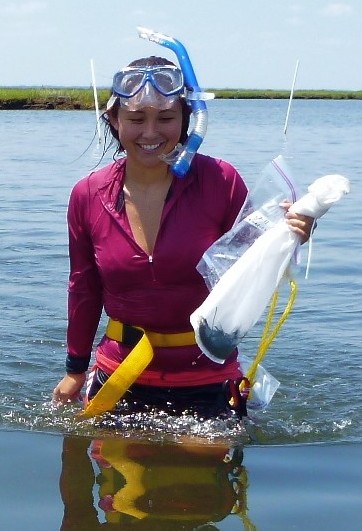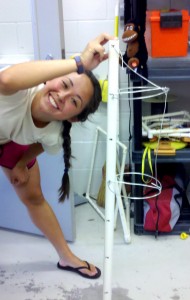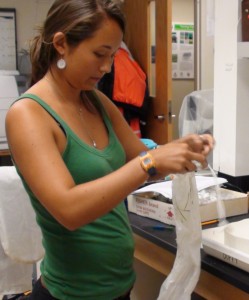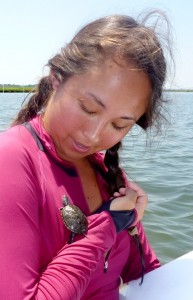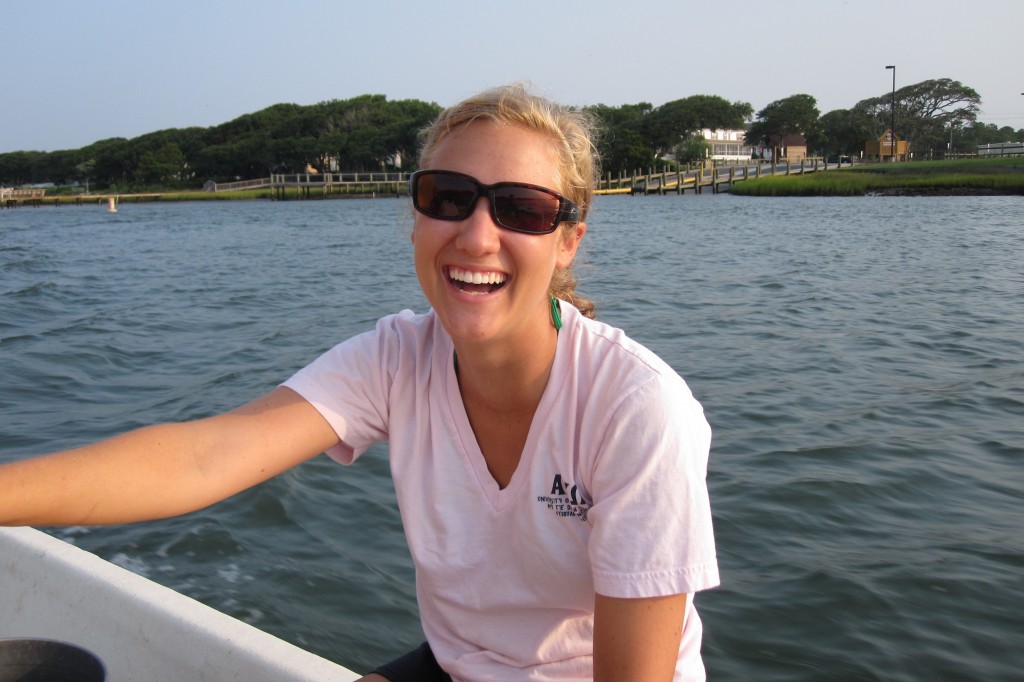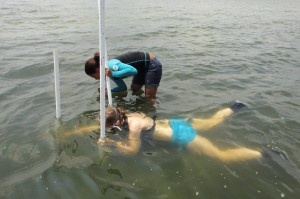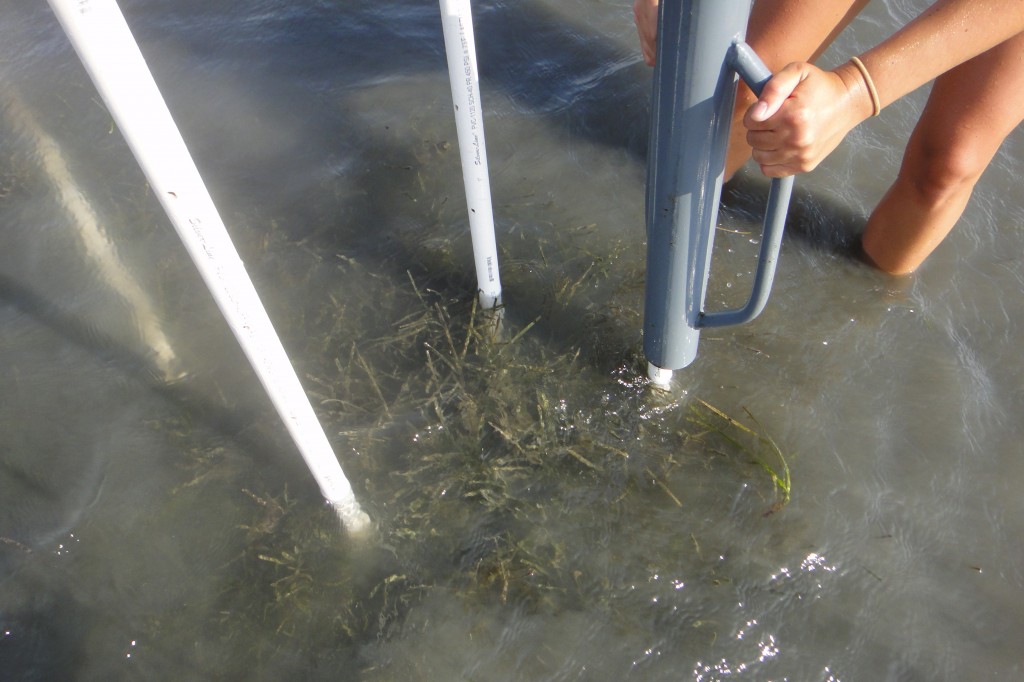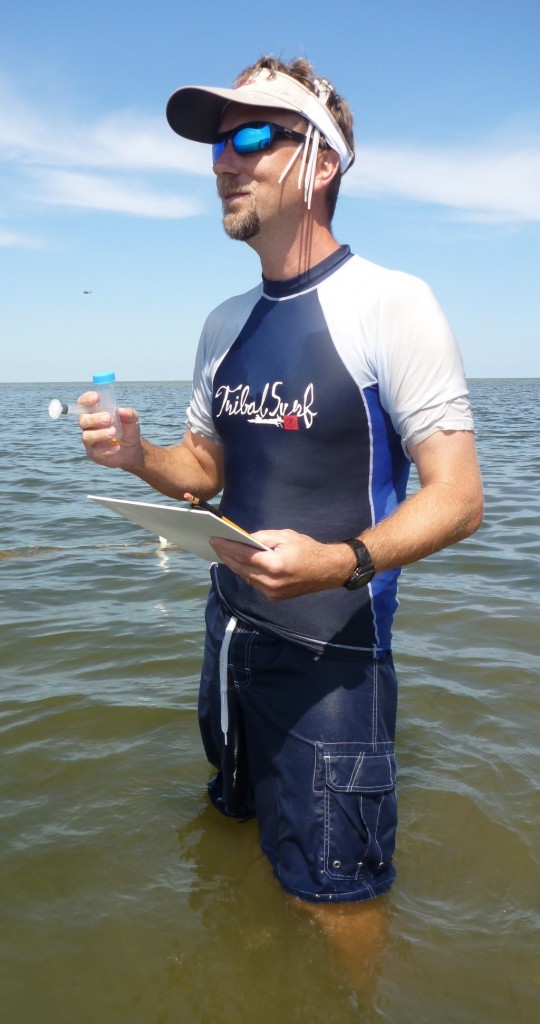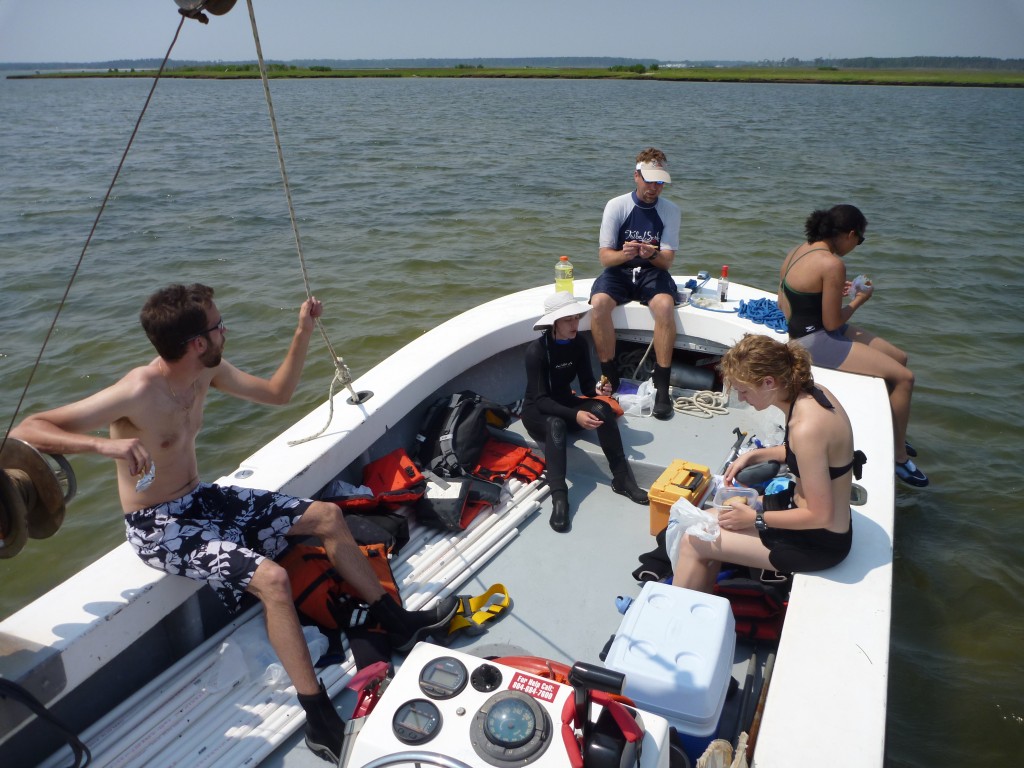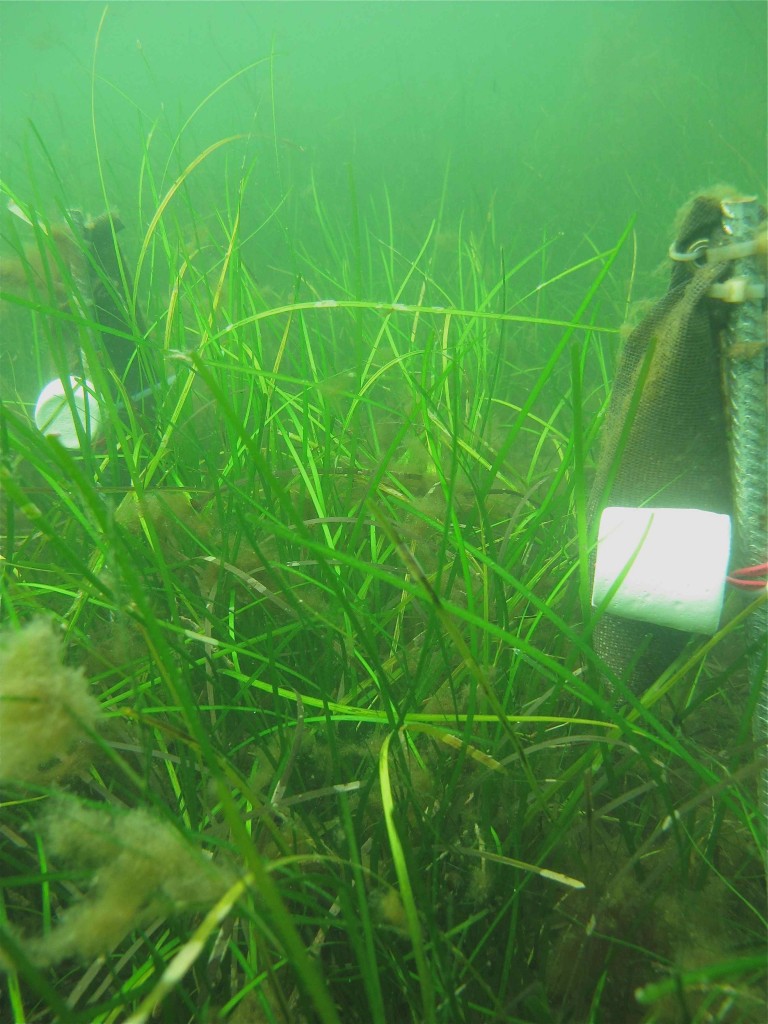Typical day at the ZEN British Columbia field site
by Carolyn Prentice (Univ. British Columbia undergraduate at ZEN Vancouver, British Columbia Site)
My experience working on the ZEN project in Dr. Mary O’Connor’s lab this past summer was simply fantastic. It was great to have a summer job that I was really passionate about; anytime anyone asked me what I was doing for the summer, they were in for more than just a one-sentence answer! It was also great to share the experience with many other passionate biologists; we had an amazing group of workers and volunteers. Even when it was rainy and windy and our hands were numb, we knew we were lucky to be doing what we were doing! I am grateful to have had such an amazing opportunity, especially as an undergraduate and working on the ZEN project has certainly inspired me to continue studying the fascinating communities that inhabit Zostera marina beds. I am also excited to see the results of the ZEN projects from all of the different sites!
A typical day for the crew at the ZEN B.C. site:
1. Pile into the U.B.C. Zoology van with equipment and keen volunteers.
2. Arrive at the field site, put on (leaky) chest waders and sun hats or rain jackets (typically the latter).
3. Head down the 300 or so stairs to the beach, pass all of the locals getting their daily exercise and wearing ‘what are you guys up to’ looks on their faces.
4. Head out onto the mud flats, try not to stop moving or risk getting stuck in the really sticky mud.
5. Go about whatever task we had set out to do that day. Meanwhile, enjoy the beautiful scenery – the nearby Gulf Islands, the B.C. Ferries sailing across the Straight of Georgia, and hundreds of foraging herons.
6. Walk back up the 300 or so stairs (great exercise!)
7. Empty the leaky waders.
8. Go to Tim Horton’s to get iced caps or hot chocolates (typically the latter) before heading back to U.B.C.
9. Go home feeling like the luckiest people in the world!
A Marine Ecologist’s New Year’s Resolutions
by Pamela Reynolds
1. Finish and submit those pesky, lingering manuscripts.
2. Apply for more funding.
3. Make more time for broad reading of the literature.
4. Figure out the species identification for sample “unknown A”… and “B”… and “C”…
5. Go digital and print less.
6. Appreciate the learning experience that comes with syntax errors in my statistical analysis coding.
7. Get out into the field more.
8. Spend less time fiddling with powerpoint slide aesthetics.
9. Fix that tear and other leaks in my wetsuit.
10. Bring healthy snacks into the field.
11. Cleanup my e-mail inbox.
First grass to see the light: ZEN in Japan
by Matt Whalen (VIMS, UC Davis graduate student)
I was excited to participate in the ZEN project because of the preliminary work I did for my Master’s research under Dr. Emmett Duffy at the Virginia Institute of Marine Science (VIMS) to test the methods in seagrass. I was also excited for the chance to get up close and personal with eelgrass (Zostera marina) in different parts of the world. I had visited eelgrass beds in Boston, Massachusetts, Bodega Bay, California, and Vancouver, Canada while visiting grad schools, and played around in tropical seagrasses in Florida while helping out with a seahorse research project a few years ago, but the bulk of my research experience in seagrass was focused on the lower Chesapeake Bay. When I found out that I would be traveling to Japan to work on not one but two of the ZEN experiments, I felt like a boyhood dream had come true. Sappy, but it’s 100% accurate. My father lived in Japan for a number of years while he was in the navy, and growing up I heard a lot of stories about his time there that romanticized the whole thing for me. He even promised me (around the time I started tying my own shoes) that we would travel to Japan together one day to climb Mt. Fuji.
The timing of the trip could not have been more perfect. At the conclusion of my Master’s degree at VIMS and before beginning my PhD at UC Davis. I spent a month and a half in the land of the rising sun. My time was split between Hiroshima Prefecture, Tokyo and surrounding areas, and the northern island of Hokkaido. No amount of Japanese anime (my favorite series being Cowboy Bebop and my most recently viewed film a Japanese rendition of the Little Mermaid named Ponyo) could have prepared me for how amazing this trip would be. My first impressions were actually in the airport and during the flight. I had scored direct flights from Washington, D.C. to Tokyo and I flew with ANA (All Nippon Airways)…“Nippon” and “Nihon” are Japanese (Nihongo) for Japan, and I’m not sure how “Japan” came into use. As is often the case (for me, anyway), international flights are far superior to domestic US flights, and ANA exceeded anything I had experienced before (I’ll let the better-traveled out there decide whether ANA or international flights generally are superior).
I made a quick list of why these international flights were awesome: Continue Reading
Thanksgiving
By Pamela Reynolds, ZEN Coordinator
I am thankful for:
1. Enthusiastic undergraduate students
2. Patient collaborators
3. Sunny field days
4. 7 mm wetsuits without holes
5. Watermelon slices and Oreos in the field
6. Days without R-syntax errors
7. Extra cable ties
8. Shipments that arrive on time
9. Polarized sunglasses and wide brimmed hats
10. Understanding partners and family
Science – it’s electric!
By Pamela Reynolds (VIMS; ZEN Coordinator) with contributions from Paul Richardson and Akela Kuwahara
There are few times in my life that I can honestly say that I was terrified. Feeling the Loma Prieta earthquake in ’89, (nearly) tripping over a cottonmouth snake, taking my qualifying exams all stand out. So does the 28th of June in 2011.
It started out as a normal day, or at least as normal as a day of fieldwork can go at the ZEN site in Virginia. It began with the usual flurry of activity in the early morning packing the experimental equipment and loading the boat, checking the associated weather websites and filling out the float plan, slathering on sunscreen and pulling on life jackets and dive booties. It was a typical hot, humid, and sunny summer field day in coastal Virginia.
As is customary, when we arrived at the site Captain Paul cranked up the VHF radio to the weather channel and its droning computerized voice began babbling in the background. We set anchor, grabbed our masks and associated collecting gear, hopped into the water, and got to work. We were collecting seagrass shoots to measure growth rates, which involved a lot of swimming and diving among our experimental plots in what we affectionately called the ZEN Pole Garden. On about plot number 22, half way through our collections shortly after 3 o’clock in the afternoon, it started. That dreaded cacophony over the VHF radio followed by the ominous blaring of the weather alarm and the warning statement that can mean only one thing – storm!
I never used to be afraid of lightning. I actually found it to be beautiful, exciting even; an awesome display of the raw power of nature ripping the sky above. My sentiments have changed. Continue Reading
A summer of adventure
By Akela Kuwahara, VIMS REU student summer 2011 (Humboldt State University)
Last week I earned my Invertebrate Zoology team at Humboldt State University 10 extra credit points for successfully identifying a gammaridean and caprellid amphipod, a mysid shrimp, and several Palmonetesshrimps! How, you ask? One word: ZEN.
This past summer I was in the REU program at VIMS working with Dr. Duffy’s Marine Biodiversity Lab. The ZEN project had just begun when I arrived in Virginia and I quickly set to work making experimental equipment and processing seagrass samples. Coastal Virginia looks nothing like the rocky California Coast where I currently go to school at Humboldt State University, nor like where I grew up on the Big Island of Hawaii.
I have had few experiences as enriching, educational, and career-focusing as my internship with the VIMS ZEN team. I had an up-close encounter with a juvenile terrapin who tried to nest in my hair, and an encounter with a sea nettle that wrapped my leg in a less than tender embrace. I became an expert at pouring cups of wet plaster, identifying a severed head or lone backside of the tiny amphipod Gammarus mucronatus, distinguishing between seagrasses Ruppia and Zostera, doing the sting-ray-shuffle, writing international UPS labels in the nick of time, and so much more.
Sadly, since my time at VIMS has ended, these skills have been poorly utilized. They have, however, given me a better understanding of marine ecology and the functioning of seagrass habitats, and they’ve earned me 10 extra credit points in Invertebrate Zoology! Emmett Duffy’s lab at VIMS is a craftily chosen group of people who have collectively helped to steer my interest in graduate studies towards subtidal ecosystems and their global presence and impact. I can’t wait to hear about where the ZEN is headed, and the progress that it has made. It was a summer well spent.
Photos by JE Duffy, PL Reynolds, JP Richardson
A ZEN-like beginning in North Carolina
By Megan Gyoerkoe, UNC Chapel Hill undergraduate student
One morning, bright and very early, the North Carolina ZEN team packed up the truck and with all the necessary materials for the initial set up of all 40 experimental plots for our experiment. We arrived at our field site behind the Pine Knoll Shores Aquarium and the weather was absolutely beautiful, sunny and warm but with a cool breeze. The tide was calm and the Zostera seagrass beds were vast and lush. After briefly meeting with the aquarium staff our group got started right away, driving the 120+ poles needed to mark the experimental plots into the sediment. About half way through Pamela began to check some of the plots to make sure they had enough Zostera (we were aiming for a minimum of 80% cover). As it turns out what we thought were lush beds of Zostera were actually composed mainly of a different type of seagrass – Ruppia! You can understand that this is a problem given that we are working on the Zostera Experimental Network (ZEN) and not, well REN!
We had spent all morning driving poles into the sediment only to discover that we had been deceived by the seagrass. In disbelief that we could have made such a mistake, we checked and double-checked the plots. Then we went on an extensive Zostera hunt, searching endlessly for a hint of a healthy Zostera bed, swimming through the seagrass even under the threat of being hit in the face by jumping mullets! Turns out it was all in vain and it was back to the drawing board for the ZEN-NC site. What had been an extensive Zostera bed two years before had been replaced almost entirely by Ruppia and some Halodule seagrasses. We spent hours pounding in the poles only to pull them back up the next day.
Fortunately, Pamela, Erik and Rachel were able to work out the logistics for us to work at a new site nearby in Middle Marsh that was actually filled with beautiful, lush Zostera. Even though we had to re-set all of the poles, it turned out to be a wonderful, protected site that was a pleasure to work in.
Field research is definitely a category on its own; it is pleasantly unpredictable, entertaining, exciting and occasionally slightly torturous. Continue Reading
The ZEN Factory
By Paul Richardson, VIMS Marine Biodiversity Lab Manager
As Emmett’s lab manager in the Marine Biodiversity Lab at VIMS for the past 10 years there’s rarely been a dull moment. There is such an eclectic range of duties with this job that sometimes it’s hard to know what will come next. One day I may be driving a research vessel to field sites were we snorkel to collect samples in the Chesapeake Bay, the next I’m doing data analysis, or building materials for a mesocosm or field experiment, talking to a high school marine biology class, ordering lab supplies, or explaining to the woman at Wal-Mart that I really am buying all of their lingerie bags and knee high, queen sized, reinforced toe stockings for the purpose of science! The Zostera Experimental Network (ZEN) project has added yet more varied activities to the list. Never before have we conducted such an expansive project coordinating with 14 other research groups from around the States and the world!
First I have to say that none of this would have been possible without the hard work of the crew: volunteers Kara Gadeken, Megan Gyoerkoe, Jack Hawkins, and John Ray; our REU intern Akela Kuwahara and others; and the VIMS crew of Emmett Duffy, Pamela Reynolds, Erin Ferer, Jon Lefcheck, Nathan Bowman, and Elizabeth Bush. Marine ecology is a team sport and this crew knows how to play the game. Thanks! Also, I’m amazed to learn that it appears that all of the ZEN partners not only attempted but finished their experiments as well. As a first step, last winter we held a conference where representatives from all of the groups met in Williamsburg, VA to hash out a plan for the project. At this very productive meeting, it was great to meet all of the partners and certainly it was crucial to the success of the project. With Jim Grace’s seminars on structural equation modeling, Jim Thomas’ amphipod workshop, and all of the work sessions and other activities, the ZEN conference deserves its own dedicated post. As for me, after the meeting I worked with Emmett and Pamela to compute our materials needs, costs, vendors etc. for the network of ZEN experiments while also building on Matt Whalen’s work to formulate an ideal recipe and method for churning out the abundance of deterrent and control blocks that would be needed. I began conducting small field experiments to this end in the fall of 2010. In the spring after more trials we ultimately decided on a final mixture and we started churning them out. Continue Reading
This is science?
By Kara Gadeken, College of William & Mary undergraduate student
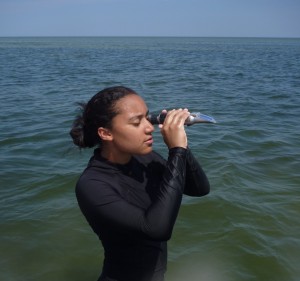
Undergraduate student Kara Gadeken takes water salinity measurements at Goodwin Islands, Virginia USA
Interning at VIMS during the hectic months when the ZEN project was at its peak was an experience that I will never forget.
The main reason that I wanted to take part in it was that, as an impassioned yet inexperienced college student, I had a reasonable knowledge base in biology but had no idea what it was like to actually do research, much less to be a part of such a grand-scale project as the ZEN. I approached Dr. Duffy at the suggestion of one of my professors at William and Mary, and luckily enough at this point his lab could use all of the help I could give.
I think the first thing that I realized while working in the Marine Biodiversity lab was that an insane amount of planning and preparation goes into research. Pamela had sticky notes and checklists and reminders all over everything in the lab, and two weeks of putting supplies together could count on one efficient day in the field. I also discovered that biologists, and especially experimental ecologists, almost have to have some engineering blood in them. In my first week at VIMS I sat in on a lab meeting to figure out how to design and construct cages to exclude predatory fish and crabs out in the seagrass beds. Time after time I heard, “How about this random thing? Hmm, I’m not sure that’ll work…How about this other random thing? Yeah, we can make something out of that!” Someone would hold up a piece of bent wire, some cable ties, bits of rope and mesh, some plastic plates. They hurled out idea after idea, trying to come up with something that could be constructed into a cage-like apparatus that would anchor into the sediment and withstand the waves. I remember stitching mesh together on an industrial sewing machine thinking, “This is science?” It didn’t take me long to realize that experiments are complicated. Not everything is perfect, and sometimes you have to work with what you’ve got, or make something new. Continue Reading
The dawn of ZEN
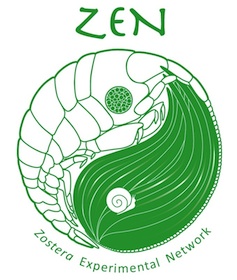 By Emmett Duffy, VIMS, ZEN Master
By Emmett Duffy, VIMS, ZEN Master
May I have the drum roll please . . .
Welcome, Ladies and Gentlemen, to the new official online home of the Zostera Experimental Network, known informally as ZEN. We are a global network of marine ecologists and evolutionary biologists from 15 sites (so far!) around the world, united in a quest to figure out how ecosystems associated with eelgrass (Zostera marina) work. The project has been seeded with generous support from the US National Science Foundation.
Eelgrass is one of the most widespread and important plants of the world’s shallow coastal seas and estuaries, ranging from above the Arctic circle to the balmy climes of Portugal, North Carolina, southern California, and southern Japan. ZEN has partner sites in all of those places. Extensive meadows of eelgrass support rich and productive biological communities of fish and shellfish, and provide important living buffers against storm and hurricane damage. As you might imagine, environmental pressures differ profoundly acros its broad range, from the glacial landscapes of northern Norway to the sweltering heat of the American southeast, as do the types of animals that live among the eelgrass. For these reasons, eelgrass beds are ideal candidates for exploring how gradients in environment and biodiversity influence the complex functioning of ecosystems.
ZEN is coordinated by myself and Dr. Pamela Reynolds at the Virginia Institute of Marine Science. We started officially in December of 2010 with a kick-off meeting that brought partners to Williamsburg, Virginia to plan strategy and finalize methods for our first big field experiment conducted in summer 2011.
On top of our day jobs, Pamela and I have been busy lately sorting the big trove of images from ZEN’s first global experiment in summer 2011, and wrestling with HTML code and other such arcana, in an effort to get the ZEN website up and running. There are still a few bugs to work out but we’re now pulling back the curtain, so voila! We hope you’ll find the site useful. For example you can find:
1) A list of ZEN’s participating partners and a little about the sites where they are working here. Stay tuned to the ZEN blog for updates on activities throughout the network.
2) A summary of the 2011 field experiment here — and first-hand accounts of the experiences of some of the students and others that participated here.
3) News of ZEN activities, publications, and research findings here.
And of course you can always leave a comment or send us an email using the little box at bottom of the page. Thanks for visiting. Y’all come back!

